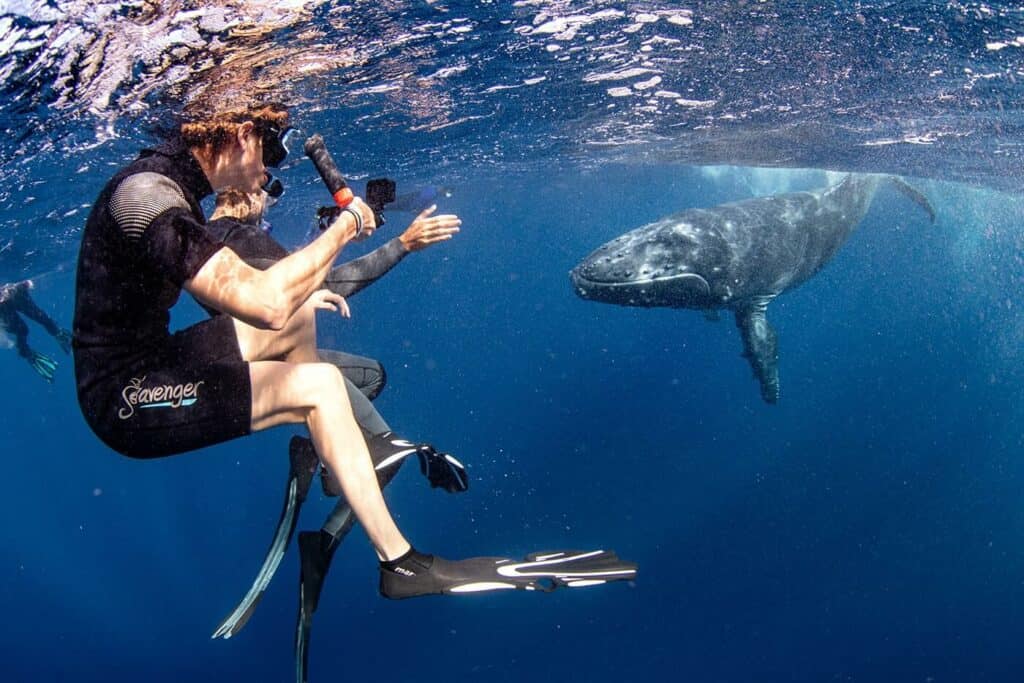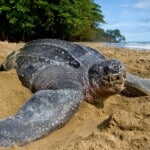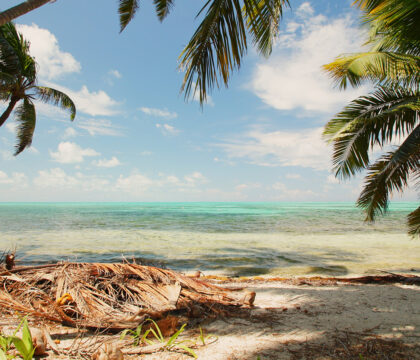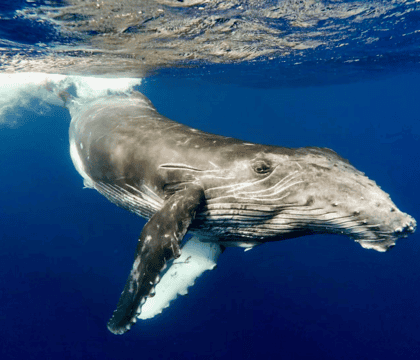March 19, 2025 • Travel Ideas
The Kingdom of Tonga, located in the heart of the South Pacific, has become a premier destination for eco-conscious travelers seeking the incredible opportunity to swim with humpback whales in the wild. This island paradise offers one of the few regulated opportunities worldwide to respectfully encounter these magnificent marine mammals in their natural habitat. In this comprehensive guide that takes advantage of our 20+ years of leading whale swimming tours in Tonga, we answer the most common questions to help you prepare for the life-changing adventure of swimming with whales in Tonga.
Table of Contents
- Safety Information
- Tonga’s Whale Swimming Regulations
- Best Time for Swimming with Whales in Tonga
- Water Conditions
- Typical Day on a Whale Swimming Tour
- What to Bring
- Health Considerations
- Family-Friendly Information
- Other Things to See While Snorkeling in Tonga
- Additional Activities in Vava’u
- Conservation Status
- Global Swimming Locations
- Plan Your Trip
Is it safe to swim with humpback whales?
Though massive, humpback whales are often called “gentle giants.” They are curious and acutely aware of their surroundings, and swimming with humpbacks can be a safe experience when certain guidelines and precautions are taken.
Our commitment to safety is one of the reasons that we lead whale swims exclusively in Tonga, where strict government guidelines ensure both guest safety and whale welfare. With experienced local guides and adherence to the regulations, our Tonga expeditions prioritize a safe and respectful experience for both swimmers and whales.
What are the regulations for swimming with whales in Tonga?
Tonga’s regulations are designed to ensure respectful, safe, and low-impact interactions when swimming with whales in Tonga:
- Small Group Size: A maximum of four guests and one licensed guide are allowed in the water at a time to ensure safety and minimize stress on the whales. Only one operator is allowed per pod.
- Time Limits: Each whale encounter is limited to 90 minutes, followed by a mandatory one-hour break before new snorkelers can enter the water.
- Daily Time on Water: Boats are restricted to a maximum of seven hours on the water daily.
- Licensed Operators Only: Only certified whale-watching providers can approach whales within 300 meters. Only licensed swimming providers can place swimmers in the water.
- Safe Distances: Swimmers must stay at least 5 meters (16 ft) from whales, and vessels cannot approach closer than 10 meters (33 feet) for swimmer pick-up or drop-off, except in emergencies.
- Noise Control: Loud or disturbing noises near whales are prohibited.
- No SCUBA or Artificial Lights: SCUBA diving and the use of artificial light sources with whales are strictly forbidden.
These guidelines ensure safe, sustainable, and respectful encounters, creating a harmonious experience for both guests and whales.
What is the best time of year for swimming with whales in Tonga?
Humpback whales start arriving in Tongan waters in late June and can be seen through October. August and September are considered the best months to swim with whales in Tonga.
How cold is the water when swimming with whales in Tonga?
Water temperatures hover around 75°F during whale season, so wearing a 3mm wetsuit is recommended. Air temperatures are in the mid-70s (Tonga’s winter) though it can get breezy, so a windbreaker or jacket is a handy addition.
How calm are the waters in Tonga?
While the scenery is often pristine, the surface conditions can be choppy. On a recent expedition, we experienced average swells of 4 feet, with the highest reaching nearly 10 feet. It’s essential to be comfortable in the open ocean, as there are no reefs nearby—just you, the guide, the boat, and the whales. Durable fins are also a must.
What can I expect during a typical day swimming with whales in Tonga?
Each day begins with a briefing before heading out by boat to locate the whales. Once found, guests will take turns swimming with them under the guidance of a licensed whale guide. You can expect to be out on the water for about six hours, returning to the resort by mid-afternoon. Sundays are a day of rest in Tonga, so no water activities are permitted. For more information about this experience, see our naturalist’s report from a past Tonga expedition.

Guests can expect to be out on the water for about 6 hours during a typical outing to swim with whales in Tonga. Only a portion of the time is spent in the water with whales, in small groups, following the direction of a licensed guide. © Doug Perrine
How long can we stay in the water with the whales?
Each whale encounter can last up to 90 minutes and typically involves multiple “drops,” where groups get in and out of the water depending on the whales’ behavior and conditions. After 90 minutes, there’s a mandatory one-hour wait before another group can enter. The exact time spent in the water depends on whale behavior, as guides carefully monitor interactions to ensure a stress-free experience for the whales.
What should I bring for my whale swimming experience in Tonga?
You’ll need a wetsuit and snorkel gear, including durable fins. Essentials also include reef-safe sunscreen, a hat, sunglasses, a jacket, and an underwater camera to capture the adventure. Don’t forget to bring motion sickness medication if you’re prone to seasickness.
Are there any health considerations before swimming with whales?
It’s important to be in good health and comfortable swimming in open water that is sometimes choppy. Tonga is a remote destination with limited medical facilities. The most common ailment is seasickness, and it is recommended to take preventative medication during your expedition to ensure you can fully enjoy your experience.
Can children participate in swimming with whales in Tonga?
Policies may vary by operator, but most require that children be strong swimmers and that they are always accompanied by an adult. As mentioned elsewhere in this guide, swimming with whales in Tonga requires strong swimming skills, including the ability to swim in open water that is sometimes choppy. If traveling with children, it’s also advisable to go later in the season, as the whales are getting older and more spatially aware at that time.
What else can I see while snorkeling in Tonga?
Although humpback whales are the star attraction, a variety of other open ocean species may be seen in Tonga’s waters while observing humpbacks. Sightings from some of our past trips have included hammerhead sharks, pilot whales, dolphins, spotted eagle rays, and sea turtles.
Beyond open ocean wildlife, Tonga is also home to beautiful coral reefs. On our Tonga trips, we also make time to snorkel among colorful coral reefs, with flowing soft corals, sea fans, reef fish, a wide range of invertebrates, and other reef-associated species in shallow waters with great visibility.
A Picasso triggerfish in Tonga. © Doug Perrine
What else is there to do in Vava’u?
At Tongan Beach Resort, where Oceanic Society groups stay, you can enjoy snorkeling right off the beach, explore nearby reefs, or try other water activities like kayaking and paddleboarding. Just a short taxi ride away, the local town offers handicraft shops, markets, and more.
Since Sundays are a mandated day of rest in Tonga, you can take the opportunity to attend a vibrant church service to experience the culture, relax on the beach, birdwatch, or snorkel for a peaceful day of leisure.

Sunday is a mandated day of rest in Tonga. © Doug Perrine
Are humpback whales endangered?
Yes, humpback whales are classified as endangered, largely due to historic whaling, but they have made a remarkable recovery thanks to conservation efforts. Tonga declared all its waters a sanctuary for whales in 1978—years ahead of many other nations. The “Tongan Tribe” sub-population was as low as 250 individual whales prior to the ban, but has since rebounded to the low thousands, with hundreds of whales visiting Tonga each season.
Where in the world are you allowed to swim with humpback whales?
Only a few places globally permit swimming with humpback whales, with Tonga being one of the most reputable and responsible destinations. Vava’u, Tonga, is known for regulated, eco-conscious whale tourism, setting it apart from more crowded spots like Moorea in French Polynesia. For more information see our guide to where to swim with whales and whale sharks.
The Experience of a Lifetime: Plan Your Trip
Swimming with humpback whales in Tonga is more than just an adventure—it’s a deeply humbling experience. Seeing these magnificent creatures up close in their natural environment leaves a lasting impression that changes the way you see the ocean and its inhabitants.
Beyond the thrill of the encounters, this trip is about conservation, respect, and appreciation for marine life. By participating in responsible whale tourism, you are contributing to the ongoing efforts to protect these whales and their habitats. Whether it’s the sight of a mother and calf gliding gracefully beneath you, the melody of a whale song, or watching a breach from the boat, each moment is unforgettable.
If you’ve ever dreamed of a life-changing wildlife encounter, this is it. Sign up to swim with whales in Tonga today! For travelers looking to make the most of their time in the South Pacific, we also offer trip that not only lets you swim with whales in Tonga, but also visits Fiji for several days of snorkeling.




